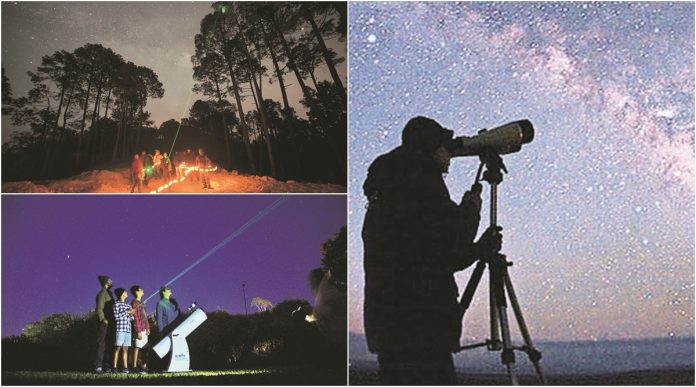For Neeraj Ladia, ‘astro gazing’ or gazing into outer space has been the greatest mystery for humans. “You are amazed to see the movements in the sky, fantasise about the magical twinkling existence. Astro gazing has brought me to a different learning in life. You realise how small a person is in the universe,” says the Chennai-based astronomer and astro-photographer, who is also the CEO of Space Arcade, a multi-channel brand for astronomers and outdoor enthusiasts specialising in telescopes and binoculars.
While Ladia’s expertise lies in astrophotography, he’s a mechanical engineer by degree and astronomer at heart. “I like to visit new and quiet places while capturing the night skies in my mind and camera forever,” he says, explaining how the next six months are jam-packed with celestial activities—eclipse, meteor showers.
It starts with Perseids meteor shower around August 9-13, followed by Draconid meteor shower between October 6 and October 10, as well as a partial solar eclipse to occur on October 25, visible over Europe, western Asia, and northeast Africa.
Massive sky-related activities, land spaces and dark sky sites determined at the specific time of the year have given impetus to ‘astro tourism’, which is no more just a passion for a few astronomy enthusiasts but has become a great concept to promote tourist destinations and experience eclipses, meteor showers and other celestial events. “Such events add to your travel itinerary. With places becoming more accessible, there is interest in travel to far-flung areas or exploring new places, and stargazing activities can add value to their travel, in conjunction with the planned itinerary,” says Ladia.
In the past few years, India has opened up to the potential to foster astro tourism in places like Rajasthan, Leh, Ladakh and the hills in north and south India. But this sort of adventure is extremely niche, says Paul Savio, CEO and co-founder of Starscapes, a platform that offers a holistic astronomy experience. He cites reasons such as lack of awareness among Indians.
“There is increasing adoption of astronomy experiences and latent interest in the subject already. We have reached out to people looking for new experiences, and not just those who seek astronomy experiences. Thus, it helps introduce many people to this field. The objective is to reach out to casual astronomy enthusiasts who take interest in the field,” says Savio, who joined Starscapes when it started as an observatory in Kausani, Uttarakhand in 2015 by amateur astronomer Ramashish Ray, the founder of Starscapes.
“It is critical to be present at locations which are a drive away from big towns with locations that have fairly dark skies, measuring 4 or less on the Bortle Scale (a measure of night-sky darkness, 1 being extreme remote locations and 9 being inner cities). The locations are also important tourist spots since novel experiences are sought out and best enjoyed by tourists,” adds Savio.
It started with just a telescope installed at the cottage in Kausani that made guests explore the night sky. This was followed by setting up a small observatory with ticketed shows. “People who visited us were not searching for astro experiences—they were looking for something new. And this insight led to us creating a platform to provide astronomy experiences to everyone in 2017,” adds Savio.
Sky’s the limit
Apart from the positive effects of the pandemic that gave access to clear skies when most people were housebound, today night sky offers a good opportunity to learn about stars, constellations, planets and meteor showers.
In 2009, the first eclipse passenger flight in India was organised to watch total solar eclipse in Taregna, a village in Bihar which is 35 km from Patna and literally translates to ‘counting stars’. The place is best known for astronomer Aryabhatta, who had set up a camp to study stars. Travel firm Cox & Kings had organised a flight for both amateur astronomers and others to watch this rare total solar eclipse.
Besides experiential tourism, stargazing is popular in Rajasthan, Ladakh, and Pondicherry. The Ladakh administration, in association with the Indian Institute of Astrophysics, plans to promote astro tourism in Hanle village in the coming months. Rajasthan’s state department of art and culture in Jaipur has introduced a ‘night sky tourism’ project to encourage tourists a visual night sky through the telescopes set up at Amber Fort, Jawahar Kala Kendra and Jantar Mantar.
The Bikaner House in New Delhi has also been chosen as a hub for astro tourism and a telescope will be installed for tourists for sky watching soon. Rajasthan chief minister Ashok Gehlot announced the installation of telescopes in 33 districts to promote science environment. “In addition to this, the Sambhar festival at Sambhar, a less explored destination, promotes astro tourism and night tourism through the beautiful long patches where you do not have any habitation and you can see the night sky with stars and the Milky Way very clearly,” says Gayatri Rathore, principal secretary tourism, Rajasthan, in an interview with FinancialExpress.com.
Starscapes has been working in dark sky locations for a mobile observatory in Pondicherry at the Club Mahindra property for a holistic astronomy experience. The company has also partnered with the Uttarakhand Tourism Board to develop Benital as India’s first astro village.
“Initiatives like these are slowly becoming a priority for many other state governments. We host astrophotography sessions, planetary parade, and the ‘Messier Marathon’ across our observatories in Kausani, Bhimtal, and mobile observatories in Virajpet, Madikeri, Goa and Munnar. The plan is to open observatories in 28 towns across India in the next three years, and roll out products such as tours and parties in partnership with travel operators, resorts and hotels to reach out to as many customers as possible,” says Savio, who uses Celestron 8” GoTo motorised automatic telescopes and 8-inch Dobsonian telescopes for shows held around the observatories to observe planets up to Neptune, surface features of planets up to Saturn, including the clouds on Jupiter, the mountains on Mars and the Rings of Saturn.
Ladia of Space Arcade shares an example of stargazing travel to the lesser-populated hills of Yelagiri in the southeast Indian state of Tamil Nadu, a prime dark spot away from the city to watch darker skies conducive for stargazing. “In 2020, we led sessions for astro-photographers and families for short trips besides places like Sariska forest reserves in the north and Kodaikanal and Jawadhu hills in the south as astronomy getaways,” says Ladia, who is also associated with Astroport, a themed resort and activity centre in India and South Asia that offers astronomy and earth-based space experiences.
Currently, Astroport organises camps in Sariska tiger reserve in Alwar district of Rajasthan, where amateur astronomers have access to all the necessary equipment required for astronomical research like telescopes, star charts and cameras as well as an observatory. They host school groups for educational programmes and other activities. The company will expand to 20 such themed sites in the future.
Meanwhile, Science City, Kapurthala also takes students and adult tours to witness celestial bodies like the moon, Saturn and Jupiter. Besides organising various astronomical events at Jantar Mantar Observatory and Pir Ghaib Observatory in the national capital, Nehru Planetarium in Delhi organises multiple shows and workshops for a clear view of the night sky. The space is a tribute to India’s first Prime Minister, Jawaharlal Nehru, to promote his ideas on the importance of methods of science and astronomy education for children.
The tourism ministry last year under the Dekho Apna Desh campaign organised a webinar titled “Astro-Tourism: The Next Frontier of Nature-based Tourism”. The focus was to promote nature-based tourism and the evolution of astro-tourism as one of the most authentic and environment-friendly ways of travelling along with its immense potential to bring positive social, economic and conservation benefits to remote communities.
Rupinder Brar, additional director general, ministry of tourism, says astro tourism is a new phenomenon that is taking hold across the world. Capturing people’s inherent interest in the mysterious provides the drive for tourism through the ages, India has immense potential with regard to nature-based tourism having all physical geographical features of the world. The plan is to enhance domestic travel and such experiences can promote visits to lesser known and nature surrounded destinations.
While addressing the potential, the focus of astro tourism is to drive sustainable and responsible tourism which puts communities at the heart and centre of tourism. The idea can train local women in the high-altitude Himalayan desert of Ladakh, generating a strong annual income for the local communities.
ASTRO GAZING: FAST FACTS
The Perseids meteor is usually sought after by astronomers and stargazers as it is often possible to see 60 to 100 meteors in an hour from a dark place during its peak
Several factors affect stargazing. Cloud cover is the most common deterrent. Conditions like transparency, referring to the clarity in the sky, affect the ability to see the night sky. The stability of the atmosphere plays a significant role in stargazing
Move away from city lights and turn off lights in your vicinity, both indoor and outdoor. Try to get up high to get a clearer view of the horizon. Generally, the sky is at its best on crisp, clear winter nights and its worst during humid, hot summer evenings. The best views are when the moon is in a crescent or gibbous phase; so it doesn’t pollute the sky with light
The white salt marsh in Kutch, Gujarat is best for stargazers as there is no interference of light and pollution from vehicles
WHERE TO DO ASTRO GAZING
— Sambhar Lake, a drive of around 100 km from Jaipur
— Shahapur, Maharashtra
— Neil Island, Andaman & Nicobar Islands
— Nubra Valley, Jammu & Kashmir
— Coorg, Karnataka
— Yumthang Valley,
— Sikkim
— Taregna, Bihar
— Jaisalmer, Rajasthan
— Kutch, Gujarat












